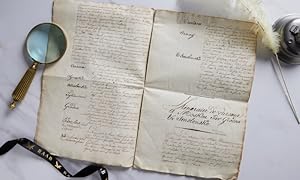Beschreibung
It is based on an 1809 intelligence operation that Napoleon commissioned to chart Persia, Russia and the steppes?A remarkable and apparently unpublished manuscript documenting Russia and its environs in the early 1800s, fascinating for that purpose as well?Acquired from the direct descendants and never before offered for sale"Resistance could only result in the burning by the assailant of a large part of the wooden houses of Moscow"?"Minsk is a town of 10,000 inhabitants of which two thirds are Jewish."?https://vimeo.com/916160568?share=copyIn 1803, Camille Alphonse Trezel obtained the rank of lieutenant in the corps of topographical engineers. The next year he was promoted to assistant engineer geographer. After the Polish campaign, as a lieutenant, he was appointed acting aide to General Gardanne, in the embassy of France to Persia. He was commissioned at this time by Napoleon to take extensive notes, topographical, geographical and otherwise of Persia and its environs. On his return, he came through Russia. On his return to France, he was promoted to Captain in late 1810 / early 1811 and assigned as an aide-de-camp to General Armand Charles Guilleminot; he became lieutenant-commander in 1813. Napoleon aimed to defeat not only Russia but England, and the latter in part through India. Trezel and Gardanne in 1809 were tasked to survey the vast regions that would have to be crossed and to probe the dispositions of the populations, and as evidenced here, did so.Trezel's notes on Persia are published and important primary resources for the period and region. We found no record of the publication of his notes on Russia.In May and June 1812, Napoleon turned to mapping the pending invasion of Russia and finding the correct route. He had few great options. As the published papers of Napoleon state, "Despite the efforts of his geographical engineers, Napoleon never had good maps of Russia throughout the campaign. To compensate for this shortage, the Paris topographical office should have drawn large numbers of the few available maps and given them to the corps commanders. This was not done on the scale that the emperor wanted.? He complained during this stretch that he needed more routes to Russia, that one would not suffice for planning, and he wrote to Generals Clarke and Berthier complaining on this subject.On June 24, 1812 Napoleon commenced his famed campaign in Russia, ordering his Grande Arm?e, the largest European military force ever assembled to that date, into Russia. The enormous army featured more than 500,000 soldiers and staff and included contingents from Prussia, Austria, and other countries under the sway of the French empire. The campaign would be characterized by the massive toll on human life: in less than six months Napoleon lost near half of his men because of the extreme weather conditions, battle, disease and hunger. On both sides, nearly a million soldiers and civilians died.General Mouton, the Count of Lobau, was a prominent general and later Marshall of the Empire for Napoleon. Mouton means "lamb" in French, the source of Napoleon's now famous statement on Mouton: "My lamb is a lion." Napoleon valued Mouton to the extent that for his great Russia campaign he made him senior aide to camp. In 1806 Mouton was a Brigade General. He would remain in Napoleon's service until the end of the Empire, during which time he showed himself to be forthright, direct (?he's no fawner?, Napoleon is noted to have said) but also disciplined, loyal, meticulous and highly organized. He was at Austerlitz with Napoleon and was charged with the preparation of the campaigns in Spain (1808), Russia (1812), Germany (1813), and Belgium (1815). Napoleon also wrote ?Mouton is the best colonel to have ever commanded a French regiment.? In 1812 Mouton took an active part in the planning and enacting of the Russian campaign. When Napoleon left the army during the retreat and returned to Paris, Mouton accompanied him.Manuscript, in the hand o.
Bestandsnummer des Verkäufers 30609
Verkäufer kontaktieren
Diesen Artikel melden
